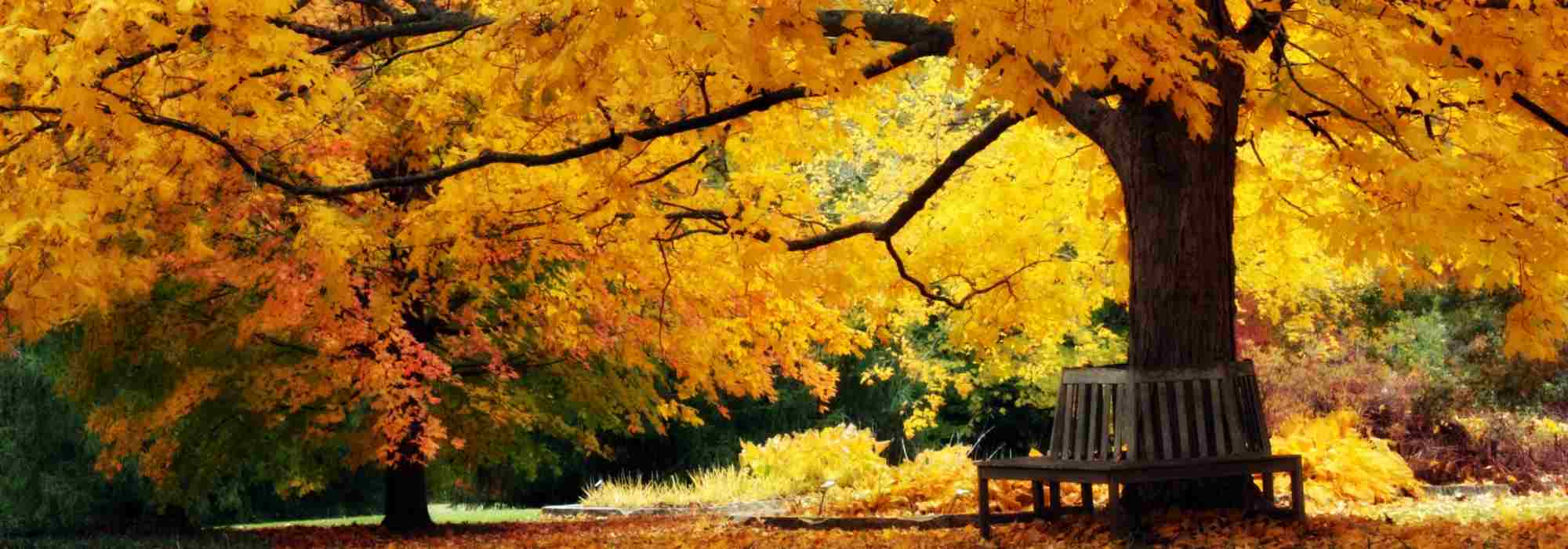
Create a beautiful autumn garden
Which plants to choose? How to use them?
Summary
Autumn is a second spring, where each leaf is a flower“. This is how Albert Camus, the famous French writer, described this incredibly beautiful and generous season. Whether gardener or not, it is indeed impossible not to notice — and not fall under the spell — of those large swathes of warm hues that blanket landscapes at this time. Certain plants then become true stars, revealing themselves as jewels to behold. Whether through their colours, their fruiting or their flowering, trees, bushes, perennials and climbing plants thus make it possible to create superb late-season displays. In this article, discover which plants to select and how to use them to create a beautiful autumn garden, inviting a little poetry.
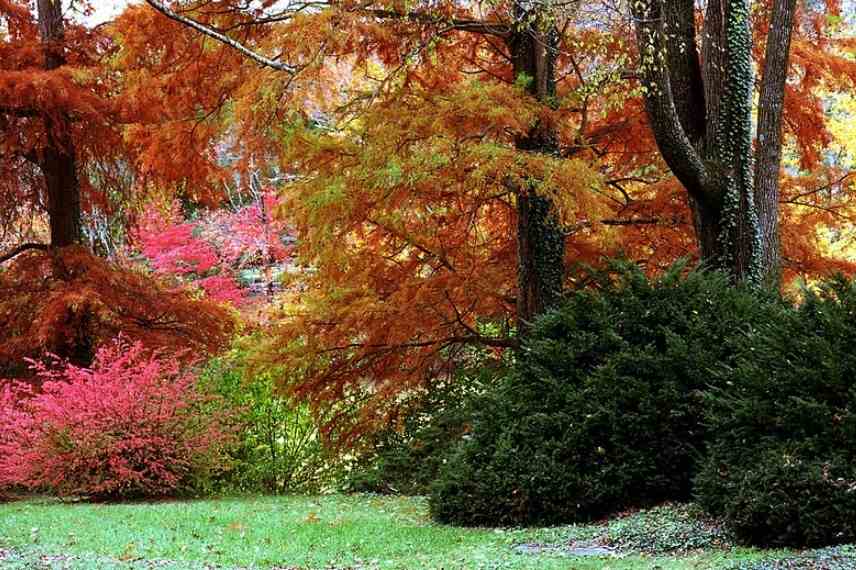
A superb autumn setting, undeniably a wonderful season in the garden! (Photo: D. Ohmer)
→ Also discover our guide: 7 superb autumn beds
Opt for foliage with superb autumn colour
No beautiful autumn garden without colourful foliage! A process linked to day length and cooler temperatures causes a change in leaf colours of many trees and bushes, mainly deciduous. They then flare up to turn red, purple, yellow, orange, violet, brown or pink, each colour declinates into multiple shades. On some plants these colours coexist on a single specimen. In any case, this very rich palette allows combinations that can, with right choices, be simply breathtaking!
To start your design, choose different trees or bushes whose colours provide pleasing contrasts. Placing two plants whose foliage turns the same red will not look as good as pairing scarlet foliage with another, golden-yellow for example.
Many woody plants are available. Choose them according to your soil, your climate and the exposure they will receive. Their mature size is also important. Small urban gardens cannot, for example, accommodate a large Ginkgo biloba, one of the references for yellow foliage, but capable of reaching over 15 m. Fortunately, there are much more modest varieties, such as Ginkgo ‘Blagon’, with a narrower habit, reaching about ten metres, or Ginkgo ‘Mariken’, which stays at 2.5 m in all directions. A terrace or balcony can even accommodate this essential genus, thanks to dwarf variety Ginkgo ‘Troll’ which, with its 1 m in all directions, fits even in a pot.
Thus, when you like a tree, check whether it comes in small-garden varieties, and in sizes that let you enjoy it, whatever space you have.
- Among the classics are Maple ‘Autumn Blaze’, Nyssa, Red oak (Quercus rubra), Tulip tree, Liquidambars, or Parrotia (Persian ironwood).
- In addition to dwarf varieties of some trees mentioned above, small spaces can accommodate many bushes or small trees. Cotinus, Amelanchier, Euonymus alatus (burning bush), some Viburnums and of course Japanese maples are all renowned for their autumn blaze.
- Climbing plants such as Virginia creeper add colour to vertical supports, and some perennials can also take on beautiful colours, like Amsonia or Persicaria.
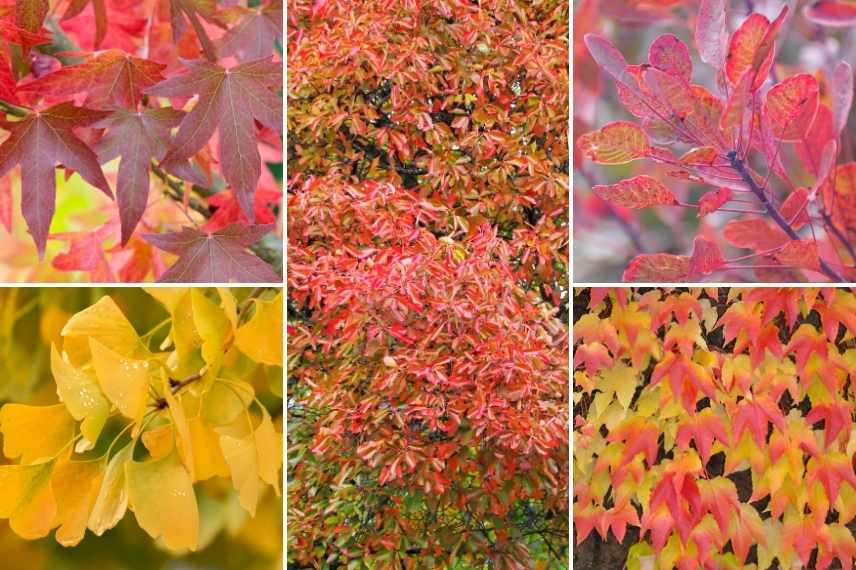
Reddish foliage of Liquidambars, Ginkgo biloba, Nyssa sylvatica, Cotinus coggygria and Virginia creeper (Parthenocissus)
→ See our very wide selection of trees and bushes with beautiful autumn colours.
→ Have a small space or a terrace? Find a tree for small gardens or a bush to grow in a pot in our online nursery.
You may also read
The most beautiful trees and bushes with autumn colouringPair bright colours with more neutral tones
Too many bright colours placed next to each other can tire the eye, and end up ‘flattening’ the composition. To add depth to the whole and showcase specimens with strong colours, insert plants with more neutral or cooler tones. Green comes in many shades, from darkest to palest. It provides a soft, natural link and must be well placed to play its role. To make colourful foliage stand out, plant the specimen against another with green foliage positioned in the background. For the effect to work, background plant should be larger so it does not disappear completely behind its neighbour. You can also intersperse small trees or bushes with green foliage in the foreground or staggered rows, against which brighter tones can bounce.
Among other colours to consider, don’t forget grey (or silver) and variegated foliage. They contribute to the ‘wow’ effect of your composition, and also play an important role by tempering the scene. Less neutral than greens, variegated foliage, when used in excess, muddles the message and can become tiresome. One or two specimens are enough to add aesthetic value to a border. Grey is easier to use, as it pairs with every other colour. Scattering a few plants with blue foliage adds depth to the composition, each hue then enhancing the others.
- Many conifers and evergreen trees and bushes offer green foliage.
- For grey or silver foliage, examples include Buddleia, Olive, Sea buckthorn ‘Pollmix’, weeping ornamental pear or rosemary willow.
- Variegated foliage is found in some Abelias, Cornus alba ‘Sibirica variegata’ (or its cousin Cornus alternifolia ‘Argentea’), Daphne ‘Rogbret’, Privet ‘Argenteum’, and many others…
- Blue is well represented among many conifers (Blue Atlas cedar, blue spruce, Juniper ‘Blue Carpet’…), but also in Mexican blue palm or Hosta ‘Halcyon’.
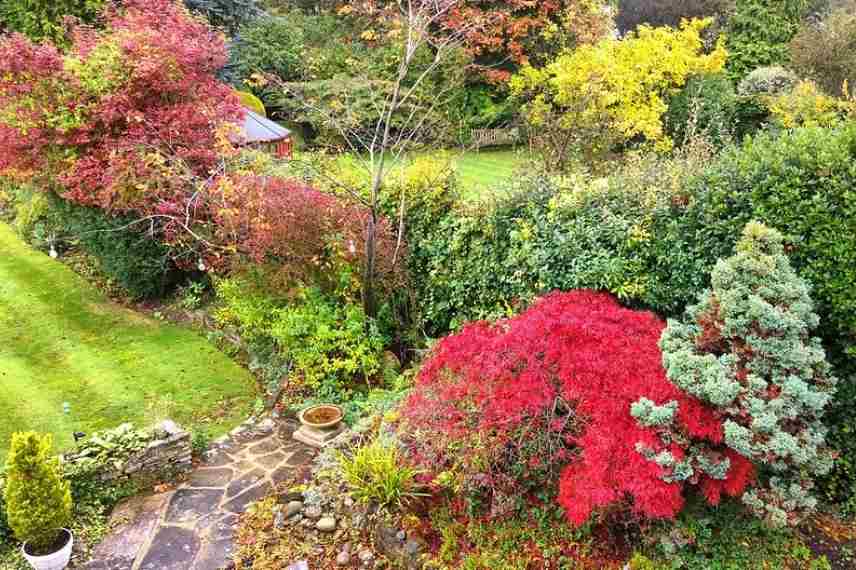
Beautiful effect of warm tones paired with green and bluish hues, mixing deciduous and conifers (Photo: T. Snewton-Syms)
→ Discover our wide range of conifers.
→ All our trees and bushes with blue foliage, silver-grey or variegated.
Add lightness with ornamental grasses
Grasses are among autumn’s queen plants. Developing in spring and summer, many reach their peak late in season, both thanks to their airy spikes and the warm colours some display. Their fine, linear foliage provides an interesting contrast with foliage of other plants, and their supple habit lends an undeniable lightness, even more pronounced when wind sets them dancing. Very easy to to grow and maintain, often with rapid growth, they are ideal to quickly fill a slightly bare border. Their ornamental value in an autumn border is undeniable, especially as they come in a wide range of sizes. They can be inserted at different levels: the lowest make excellent groundcover, at front of borders, in low hedges or to mark corners; the tallest form handsome screens or create striking focal points in beds. Very easy to combine in garden and their foliage often remains decorative almost all winter, after taking colours that, for some species, rival those of the finest trees.
- Among most beautiful specimens, try Pampas grass, Miscanthus nepalensis, Pennisetum macrourum or Molinia ‘Transparent’…
- Autumn colours of some Miscanthus (Ghana, Malepartus, Purple Fall, Purpurascens, ..) are absolutely stunning, as are those of Schizachyrium ‘Standing Ovation’, Imperata ‘Red Dragon’ or Anemanthele lessoniana…
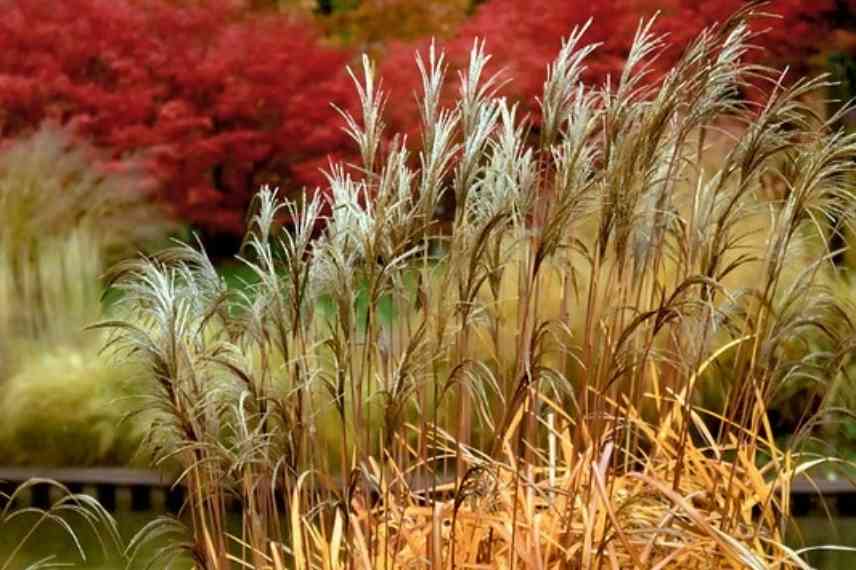
Contrast of grasses with autumn foliage is magnificent. Here Miscanthus (Photo: C. Bartnik)
→ Discover all our grasses online!
You may also read
7 superb flowerbeds for autumnCraft with berries and ornamental fruits
Once flowering has finished, many plants produce fruit that stud their branches, adding an extra decorative element. Varied in colour and shape, these berries are also a source of food for a whole range of wildlife, particularly birds. It is then an opportunity to watch their graceful comings and goings as they fly from branch to branch to enjoy this colourful, tasty buffet. Once again, the palette of colours available is quite phenomenal: black, blue, red, yellow, orange, white, pink… hard to find a colour that does not exist. While some fruits are discreet, others are as decorative as flowering displays, and their ornamental interest can last for many weeks, sometimes until following spring.
- Callicarpa, Cotoneaster, Pyracantha or ornamental crab apples are among plants appreciated for their colourful fruits and berries.
→ Choose from all our trees and decorative fruit bushes.
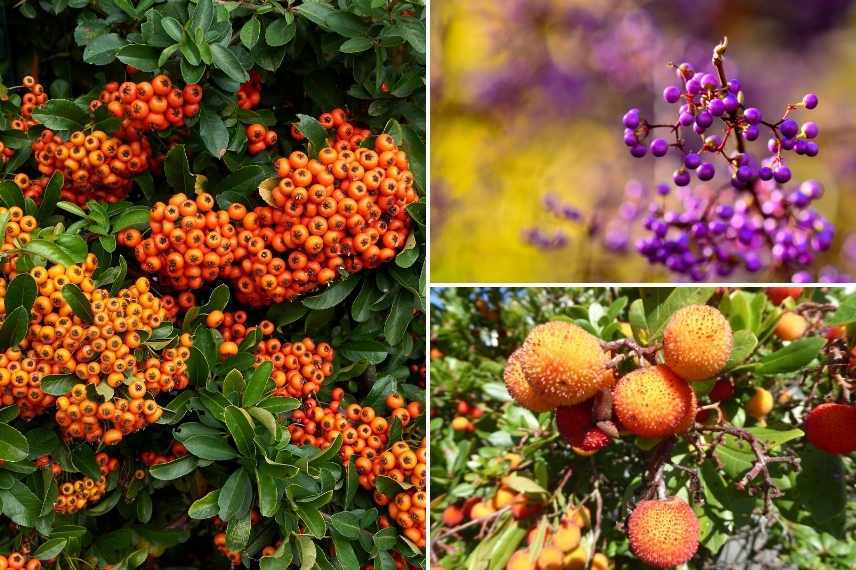
Pyracantha, Callicarpa, Arbutus unedo
Make the most of late flowering
Gardeners love flowers, and our gardens are full of them in spring and summer. However, some plants choose late summer and autumn to unveil their corollas, no doubt to attract more attention. If choice is more limited than in the “main season”, there are nevertheless many trees, bushes and perennials that flower in autumn, some even diffuse a delicate scent. Colours available are numerous. They can be warm, and then harmonise with those of foliage, allowing creation of subtle echoes. With cooler colours, work more on contrasts, to enliven the whole and create visual surprises that draw the eye. These complementary colours bring a real plus to landscaping, but beware of overdoing it. Better to proceed with small touches to avoid a messy impression. As with foliage, white is a neutral shade that tempers and ties other colours together. In gardening, everyone is free to do as they please. It’s up to you to find the balance that appeals to you.
- Autumn camellia, Caryopteris, Prunus ‘Autumnalis’, Clerodendron are some of the bushes with fine autumn flowering.
- Among perennials and bulbs, Asters, Japanese anemones, Helenium, Sedums, Dahlias, Nerines and Cannas are essential
- Certain clematis, the perpetual roses (that is, which flower several times a year) or the Solanum, flower on vertical structures.

Asters, Sedum Matrona, Anemone ‘Honorine Jobert’, Nerines, Clerodendron
→ We offer a wide range of late-flowering perennials.
Structure your flowerbeds and avoid common mistakes
- Play with foliage shapes and textures. Juxtapose the slim, upright foliage of a grass with broader, more compact foliage of a bush, for example.
- Combine low, stocky, even spreading habits with plants of upright silhouette to add depth.
- Place tallest plants at back of border, medium-sized ones in front of them, then complete foreground with small plants. That doesn’t, however, prevent creating surprises — but don’t overdo it, and above all don’t upset balance.
- Play with complementary colours (green and red, yellow and blue for example…), but also with different shades that can exist within a single colour (scarlet, burgundy, claret, plum, garnet, purple…).
- Foliage takes, in autumn, so-called “warm” tones (red, yellow, orange…). To make your composition even more interesting, don’t hesitate to add touches of “cool” tones (green, blue, violet…), whether via foliage (conifers, evergreens…) or flowering (asters or anemones, to name but a few).
- Avoid planting only plants that are attractive in autumn, at risk of having a garden that lacks interest in other seasons. Insert then some trees, bushes, perennials and bulbs that take turns throughout the year. In same spirit, accept that some plants are inconspicuous in spring and summer but later become real stars. Decorative-wood dogwoods, for example, often go unnoticed from spring to summer (especially those with plain green foliage), but they blaze into colour in autumn, and their gleaming wood is also a real asset throughout winter.
- Leave some desiccated inflorescences or stems in place, which often take brown or straw tones and marry very well (and for a long time) with autumnal colours.
- Finally, be aware that autumn colours can vary enormously from one year to the next. Temperature, humidity, wind… are all factors beyond control. Likewise, nature of your soil (more or less acidic or alkaline) influences colour changes, as does exposure (a sunny aspect favours, in many plants, late-season tones).
- Subscribe!
- Contents
































Feedbacks